| |
Significant health impact of accelerated aging in young HIV-infected individuals on antiretroviral therapy in Malaysia - higher mortality, health-care utilization, worse quality of life, more comorbidities/geriatric conditions matched to uninfected
|
| |
| |
Download the PDF here
from Jules: so far NO federal NIH HIV office or leadership has been willing to raise awareness & attention to these problems - the problems of the daily suffering of HIV+ older aging who need special support services & for their clinics too and better research - more patient focused on the real needs for the daily living issues they face. Researchers also are not focusing on the real patients needs of daily living, as well the search for medical interventions is too narrow & simple, its scope needs to be expanded. The “politics” of HIV prevents all this. There was a time the ACTG & the NIH refused to conduct lipodystrophy studies. I was ar the time on the ACTG RAC and stood up at an ACTG meeting & demanded they do this. They did. The same mentality is here, they do not want to address these problems. We need a National Discussion on Aging in HIV !
Aging among HIV-infected individuals on antiretroviral therapy (ART) is a significant clinical challenge however, studies assessing multidimensional aspects of aging are lacking. We characterised ten geriatric conditions (GCs) encompassing multiple functional domains, its health impact and associated risk factors in HIV-infected and age-matched uninfected controls. We analysed data from 336 HIV-infected individuals (total HIV+), of whom 172 were matched for age, gender and ethnicity with 172 HIV-uninfected controls (matched subset). In the total HIV+ cohort, median (interquartile range) age was 44 (38-51)years and CD4 T-cell count was 562 (398-737)cells/[mu]l. The burden of GCs was significantly higher in the HIV-infected group compared to controls (p < 0.001). With an increasing GC burden, quality of life scores were 2.2-times poorer, health-care utilisation 5-times greater and mortality risk scores 4-times higher in the HIV-infected group compared to matched controls. Both socio-behavioural and HIV-related clinical factors were independently associated with an increasing burden of GC in HIV......from Jules: HIV+ had much more depression & polypharmacy, more isolation & cognitive impairment and functional disability (see graphs below), HIV+ had worse quality of life & mor health care visits AND greater mortality risk.
low physical activity (IRR=1.25,
95%CI=1.08-1.46; p=0.004) ....... associated with an increased burden of GCs.
Conclusions: A high burden of GCs with significant impact on health outcomes, including mortality risk scores are observed among HIV-infected individuals on ART in a resource-limited setting.
----------------------------------
Significant health impact of accelerated aging in young HIV-infected individuals on antiretroviral therapy in Malaysia
AIDS March 29 2017 - Rajasuriar, Reena; Chong, Meng Li; Ahmad Bashah, Nor Syuhada; Abdul Aziz, Siti Azdiah; Mcstea, Megan; Lee, Erica Chai Yong; Wong, Pui Li; Azwa, Iskandar; Syed Omar, Sharifah Faridah; Lai, Pauline Siew Mei; Ponampalavanar, Sasheela; Crowe, Suzanne M.; Lewin, Sharon R.; Kamaruzzaman, Shahrul Bahyah; Kamarulzaman, Adeeba
from Jules: HIV+ had much more depression & polypharmacy, more isolation & cognitive impairment and functional disability (see graphs below), HIV+ had worse quality of life & mor health care visits AND greater mortality risk.
Of significant clinical implications, we found a higher burden of GCs in a largely young cohort of HIV-infected individuals with well controlled disease compared to demographically-matched uninfected controls. There was also a high prevalence of multiple GCs co-occurring in all the age groups assessed within the HIV infected cohort. An increased burden of GCs was associated with more adverse health outcomes in the HIV cohort compared to uninfected controls. This study highlights the impact of both socio-behavioral and HIV-related clinical factors on the burden of GCs in a resource-limited setting.....Mortality risks scores were also increased with an increased burden of GC but to a lesser extent in the HIV uninfected compared to HIV-infected.....Low physical activity was independently associated with an increased burden of GCs as previously described[22]. The strong interaction between intra-abdominal obesity and social isolation found in our study implied that individuals with increased intra-abdominal obesity were also those most likely to report being socially isolated with a high burden of GCs.
Interventions to improve physical fitness even with moderate levels of exercise were found to improve all of these domains in older HIV-infected individuals[54]. One third of our cohort reported low physical activity similar to other HIV cohorts[52] and thus identifies a group where a directed exercise program may help attenuate further functional decline.....A history of AIDS-defining illness (ADI) was also independently associated with the burden of GCs in our study. This is consistent with a prior study which found a history of advanced immunodeficiency as reflected by a low CD4 T-cell nadir to be associated with an increased burden of GCs[5] among middle-aged HIV-infected individuals.
Ten multidimensional GCs were assessed in all participants. In the matched subset, the prevalence of GCs was numerically higher in the HIV-infected compared to controls for all assessments (Fig 1A); with cognitive impairment, depression, polypathology and polypharmacy statistically different in both groups. The median (IQR) number of GCs among HIV-infected were 2 (1-3) compared to 1 (0-2) in uninfected controls (p=0.0176) while the proportion of individuals with one or more GCs were significantly higher among HIV-infected compared to controls, 88% vs 63%, p<0.001. When assessed by age categories, there was a higher frequency of multiple GCs present (two or more conditions) in all age groups in the HIV-infected compared to matched controls (Fig 1B). Using univariate Poisson regression, the burden of GCs was significantly lower in the uninfected group compared to HIV-infected individuals (IRR=0.65, 95%CI=0.54-0.79; p<0.001) and remained significant after adjusting for traditional factors associated with aging including smoking, alcohol, education and employment in addition to age, gender and ethnicity (IRR=0.72, 95%CI=0.60-0.85; p<0.001). The prevalence of GCs when assessed in the total HIV+ cohort (n=336) was comparable to that in the HIV-infected arm of the matched subset (data not shown).
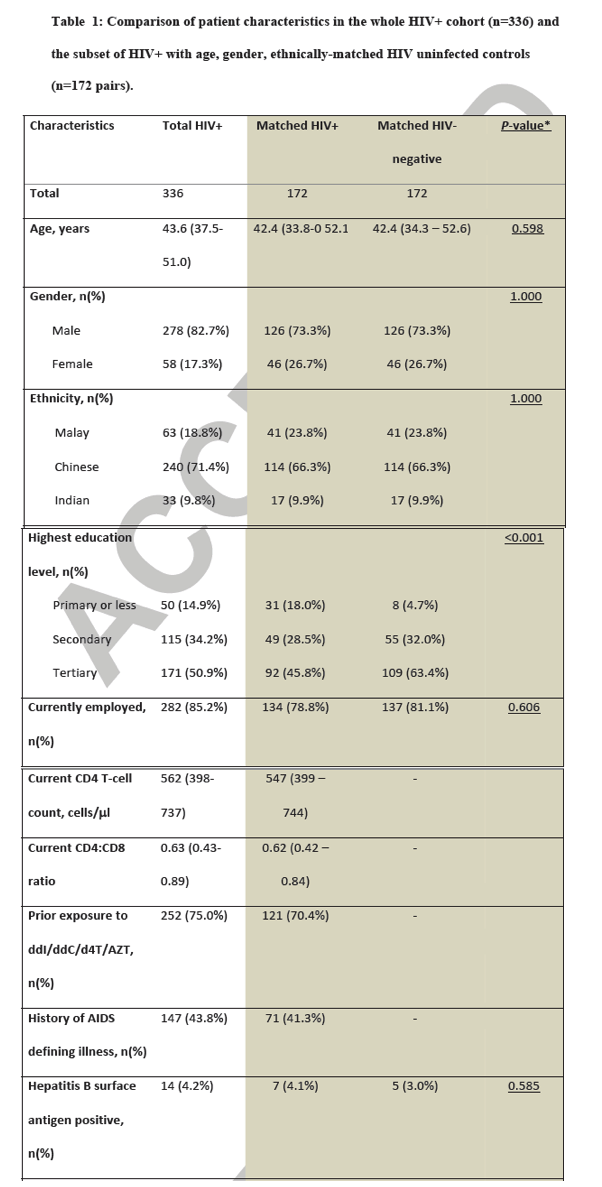
ABSTRACT
Background: Aging among HIV-infected individuals on antiretroviral therapy (ART) is a significant clinical challenge however, studies assessing multidimensional aspects of aging are lacking. We characterised ten geriatric conditions (GCs) encompassing multiple functional domains, its health impact and associated risk factors in HIV-infected and age-matched uninfected controls.
Methods: HIV-infected individuals were recruited from the out-patient clinic in University Malaya Medical Centre, Malaysia and controls from the community. All participants were aged >=25years, no acute illness and HIV-infected individuals were on stable ART. GCs were assessed and the burden scored as a composite of GCs present in an individual (total score = 10). Multivariate regression analysis was performed to determine the risk factors and health impact associated with the burden of GCs.
Results: We analysed data from 336 HIV-infected individuals (total HIV+), of whom 172 were matched for age, gender and ethnicity with 172 HIV-uninfected controls (matched subset). In the total HIV+ cohort, median (interquartile range) age was 44 (38-51)years and CD4 T-cell count was 562 (398-737)cells/[mu]l. The burden of GCs was significantly higher in the HIV-infected group compared to controls (p < 0.001). With an increasing GC burden, quality of life scores were 2.2-times poorer, health-care utilisation 5-times greater and mortality risk scores 4-times higher in the HIV-infected group compared to matched controls. Both socio-behavioural and HIV-related clinical factors were independently associated with an increasing burden of GC in HIV.
low physical activity (IRR=1.25,
95%CI=1.08-1.46; p=0.004) ....... associated with an increased burden of GCs.
Conclusions: A high burden of GCs with significant impact on health outcomes, including mortality risk scores are observed among HIV-infected individuals on ART in a resource-limited setting.
An increased burden of GCs was associated with more adverse health outcomes in the HIV cohort compared to uninfected controls. This study highlights the impact of both socio-behavioral and HIV-related clinical factors on the burden of GCs in a resource-limited setting.
We found that quality of life scores in the HIV uninfected individuals were 2.2 times higher compared to HIV-infected individuals (β‐coefficient (95%CI) =2.16 (0.98 - 3.35), p<0.001) (Fig 2A) with an increasing burden of GCs. Healthcare utilization was 4.9 times less in the HIV uninfected compared to HIV-infected individuals with the accumulation of GCs (β‐coefficient (95%CI) =-4.88 (-5.77 - -3.91), p<0.001) (Fig 2B). Mortality risks scores were also increased with an increased burden of GC but to a lesser extent in the HIV uninfected compared to HIV-infected (β‐coefficient (95%CI) =-4.03 (-6.13 - -1.93), p<0.001) (Fig 2C).

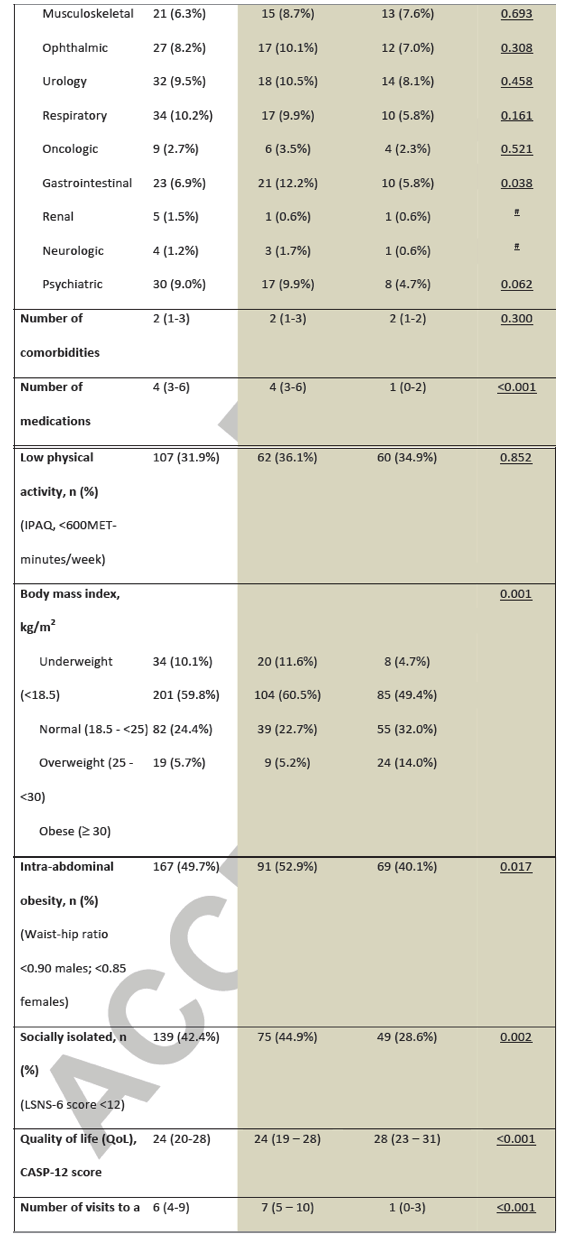
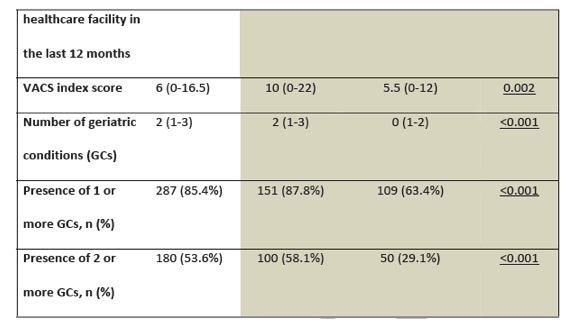
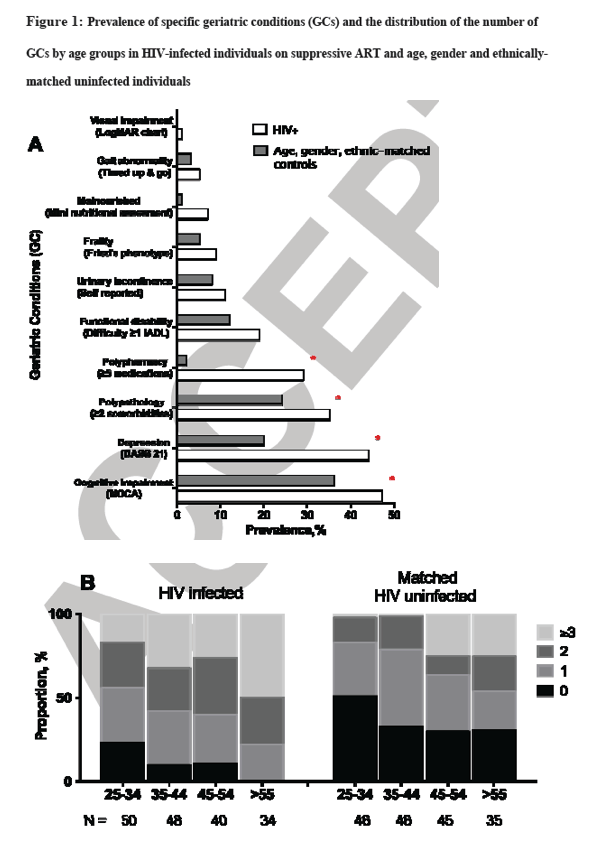
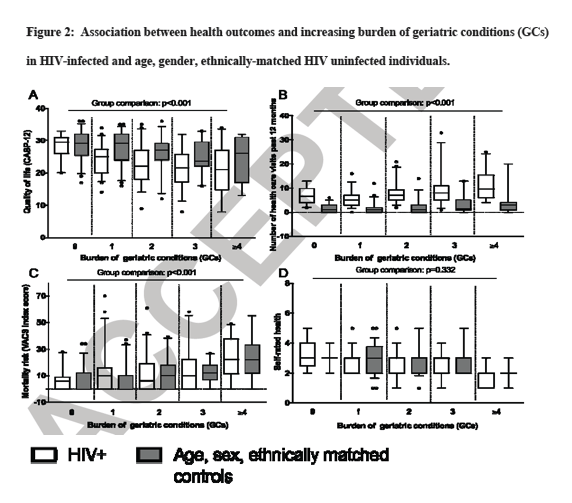

|
|
| |
| |
|
|
|